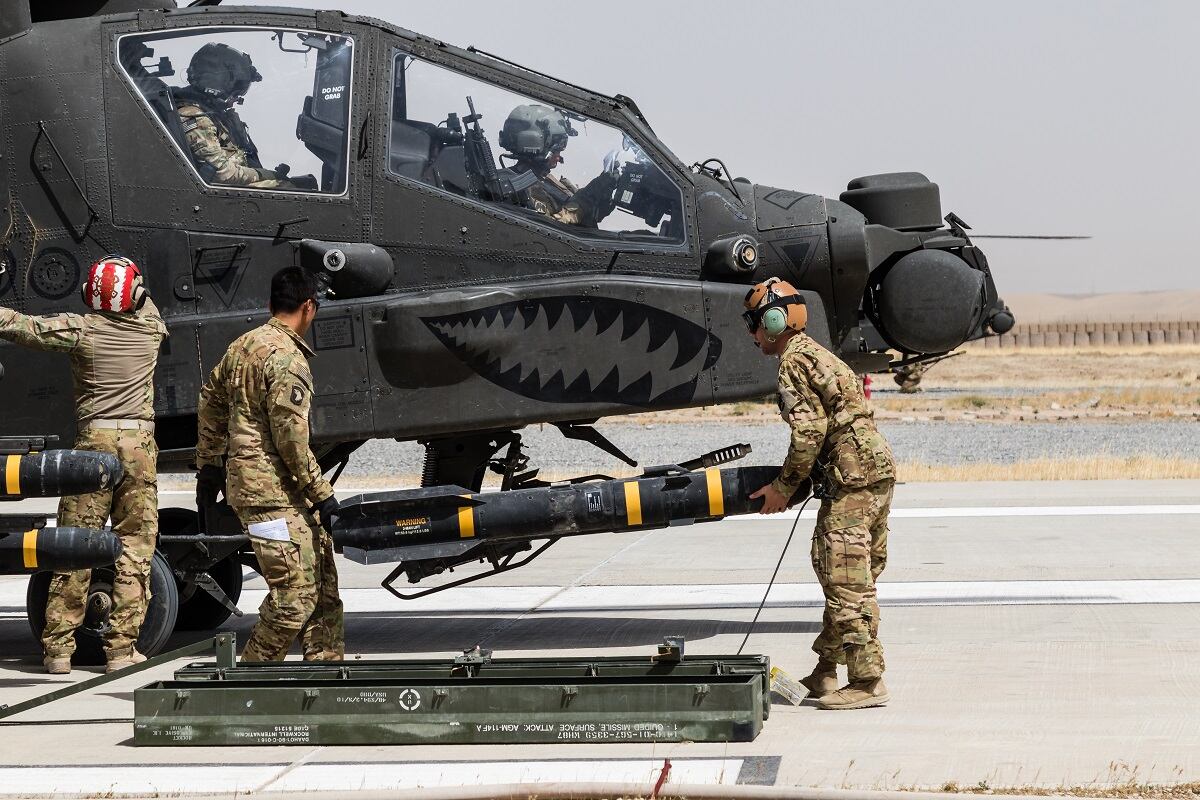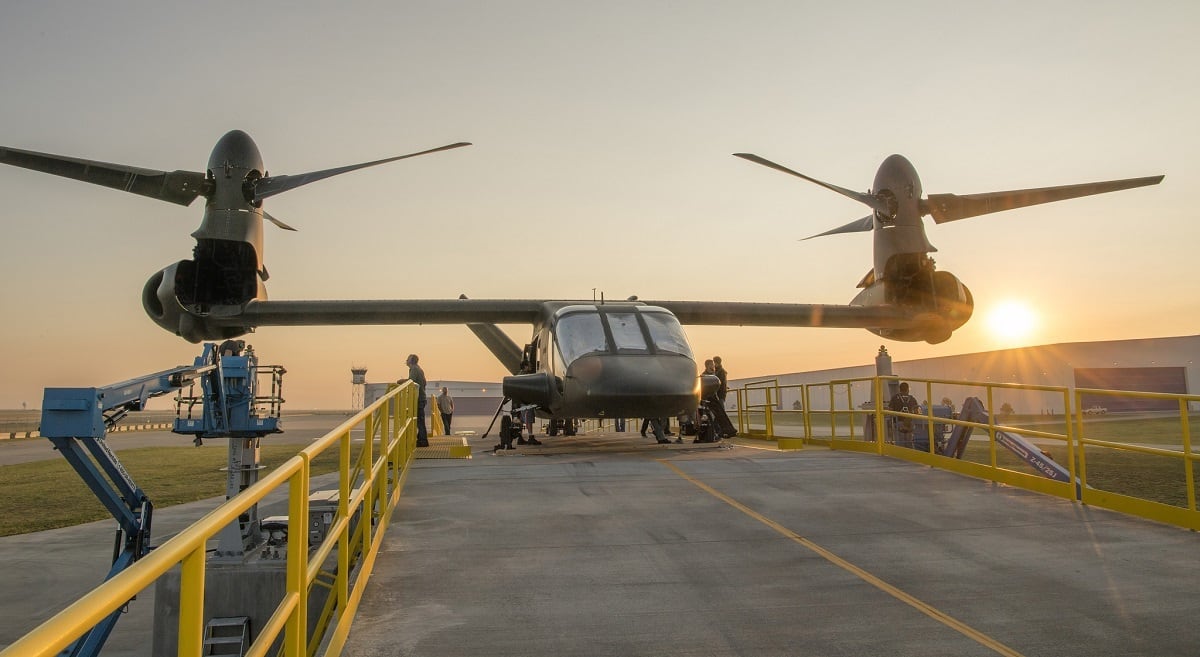YUMA PROVING GROUND, Ariz. — In the mountainous desert of Arizona, an AH-64E helicopter hiding behind 1,600 feet of craggy mountain fires a missile at a target representing a Russian Pantsir medium-range, surface-to-air missile system on the opposite slope.
The Aug. 26 scenario, attended by Defense News, was part of a U.S. Army experiment to achieve greater standoff against enemy threats using the Rafael-manufactured Spike Non-Line-of-Sight (NLOS) anti-tank, guided missile.
Maneuvering outside of the Russian system’s range, the Apache pilot was able to fire and control the Spike missile. And the Army took its experiment further by having the Apache fly at a low altitude — only a couple hundred feet above the highest obstacle in the desert — when firing the missile.
The service designed the experiment for the Spike missile and the Apache pilot to lose connectivity in the last few seconds of impact to ensure the missile could take over using its automated capability and still take out the threat.
An unmanned system, meanwhile, kept eyes on the target throughout the event, confirming to the pilot the Spike’s successful impact.
The experiment was the second firing event in the series at Yuma, and it marked a second successful shot that left the target engulfed in flames.
RELATED

The experiment at Yuma was designed and conducted by the Future Vertical Lift Cross-Functional Team, which is in charge of leading efforts to modernize the Army’s aviation assets underneath Army Futures Command, a four-star command focused on modernizing the force.
“We took a very challenging shot in this experiment,” Brig. Gen. Wally Rugen told Defense News in an interview following the event. “To me it was a [multidomain operations]-relevant shot.”
A long-range precision munition like Spike — which has the capability to defeat targets 32 kilometers away — provides the Army’s fleet with the standoff it needs from enemy targets, and it gives Army aviation an integral role in Multi-Domain Operations — the Army’s war-fighting doctrine under development. The standoff capability allows the fleet to target threats from a relatively advantageous position, as well as evade and penetrate enemy lines of defense, which leaves open a window for further maneuvering into denied territory.
Future Army aircraft with long-range precision munitions “presents multiple dilemmas,” Rugen said. “We are not tied to an airfield, we are not tied to a ship port.”
The capability paired with the range and agility of a future attack reconnaissance aircraft would also enhance the Army’s capability to penetrate enemy territory, Rugen said. That recon aircraft is one of the two future platforms the Army wants to buy.
RELATED

The service plans to conduct three more shots of the Spike missile from the Apache. On Aug. 27, the Army will fire from an even lower altitude, Col. Matthew Isaacson, the Future Vertical Lift Cross-Functional Team’s operations officer, said. The experiment will conclude Aug. 28 with one last shot.
The Army went to Israel in July with the same Apache gunners and fired Spike missiles four times from an Israeli AH-64 Delta model. Spike is battle-proven in Israel on the helicopter, which is one reason the U.S. Army chose it for the desert experiment. But the system is also growing in popularity among American allies and partners. For instance, Lithuania recently received Boxer fighting vehicles equipped with Spike NLOS missiles.
The missile has an optionally explosive warhead and can be manually guided or automatically programmed to hit a target.
All six shots taken by the U.S. Army so far have been successful, Rugen reported. The experiment is expected to inform the Army’s possible requirement for a long-range precision munition, he added.
The general also expects to finalize the requirement by the first quarter of 2020, taking it to Army leadership for approval.
What would come next has yet to be decided. Gen. Mike Murray, the head of Army Futures Command, said in an interview at the experiment that there are several possible paths if the requirement is approved — from conducting a competition to sole-sourcing to one vendor. The Army will also decide whether a long-range precision munition would focus on a future vertical lift capability or could be installed on existing aircraft.
“We always want to compete things, but this current Spike missile, if it continues to be successful, meets a lot of our threshold requirements,” Rugen said. But “we do want to look at some additional environmental aspects and the resiliency of the entire system,” such as whether it can stand up in degraded environments.
If the Army were to proceed with a purchase of Spike missiles, Lockheed Martin, which has partnered with Rafael, would likely produce the missile in the United States at its Troy, Alabama, facility where the Army’s Terminal High Altitude Area Defense interceptors are assembled and a variety of other missiles are produced. An abundance of Lockheed employees were present at the live-fire experiment.
Murray cautioned that a new, longer-range missile wouldn’t replace the Lockheed-manufactured Hellfire or its replacement, the Joint Air-to-Ground Missile, which has a range of roughly 8 kilometers. According to the general, it’s important to have multiple options that serve as a layered capability.
There are already joint urgent operational needs requests seeking an increased range of airborne precision munitions, and the service has been striving match ground-based long-range precision fires — the Army’s top modernization priority — with a similar capability in the air for several years.
Jen Judson is an award-winning journalist covering land warfare for Defense News. She has also worked for Politico and Inside Defense. She holds a Master of Science degree in journalism from Boston University and a Bachelor of Arts degree from Kenyon College.








